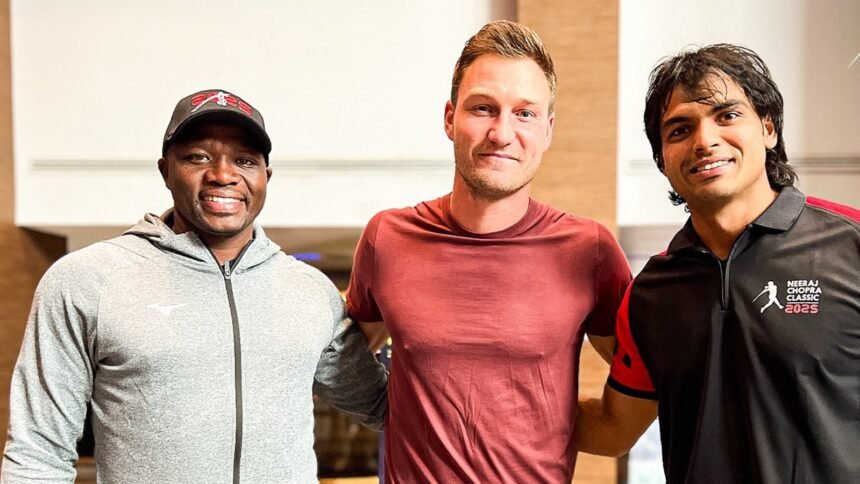World champion Neeraj Chopra smartly side-stepped a 90-metre question by saying the Kenyan Julius Yego and German Thomas Rohler would be better placed to give answers. Chopra got the 90-metre barrier monkey off his back at the Doha Diamond League in May this year. Before Yego and Rohler could elaborate on the challenge of consistently throwing 90 metres, Neeraj was double quick. “They are better people to answer,” he said half-jokingly.
Indeed, in the field of athletes at the NC Classic on Saturday, they are the two veteran members of the 90m club. Rohler crossed 90 metres seven times before a back injury put him on the sidelines. He is on a comeback trail. The physical toll, post a 90-metre throw, is immense, Rohler said.
“Throwing 90 metres has a huge impact on the body. So once you’ve thrown 90 meters, the next thing you’re going to do is rest a little bit. Because the impact is high, and people from the streets (fans) need to understand that we have one ton of weight, which is like a small car, impact on the block foot. This is javelin throwing. It’s not yoga, okay? So it’s really tough,” Rohler, the 2016 Rio Olympics champion, said.
Talking to The Indian Express, Yego, the 2015 World Champion, and a javelin throw pioneer in Kenya, described the impact of a 90m throw on the body at the time of blocking and release, akin to pulling the handbrake of a car going at 100 miles an hour. “You never know what happens inside the body because of the impact. Because you need to stop. It is like, sometimes you are going 100 kilometers in a car and you have to use the emergency brake,” Yego explained.
He gives the example of what happened after this personal best throw of 92.72 metres at the 2015 Beijing World Championships. He struggled for a while to nail a big throw. The same happened when he threw 91.39 metres at the Diamond League in Birmingham in the same year.
“When I did 91 in Birmingham, I completely shut down. When I went to Beijing, I was even struggling to make the top 8. So that 92 meters was my last chance to try to be among the top 8, but luckily it became the winning distance at the World Championship, and immediately after that I struggled a lot,” Yego said.
READ MORE | Neeraj Chopra Classic: Good host and great competitor – Neeraj Chopra ready for his dream event on home soil
Story continues below this ad
Post a 90-metre throw, an athlete feels good in training, but when it comes to competition, it is different. “I think it impacts the whole body because after competition, you feel that your body is completely worn out. I don’t know what happens because when you are training, you feel well, but when you go to a competition, the distance doesn’t come. So maybe you need to go for a service like a car, to energise,” Yego said.
Yego also caught up with world record holder Jan Zelezny, Neeraj’s coach, who is also in Bengaluru, and discussed the 90-metre challenge. Zelenzy has crossed the mark 34 times.
“I spoke with Jan yesterday evening about it. When you get onto the runway, you can never know how far you will throw. The 90 meters will come by itself. But very few athletes have maintained that standard of throwing over 90 meters for long without even a break. I think the only one who has done that many times is Jan.”
Rohler said mental toughness is also a requisite to breach the barrier. “Doing it again and again is a mental challenge. It’s about dealing with the pressure from the outside. We need to see the percentage of people in the world who threw over 90 meters. It is so small. So it’s magical and I think we should all appreciate every moment we can witness these throws.”
Story continues below this ad
The expectation of a 90 metres throw in every second competition is unfair, Rohler added. “We need to look back to 2012. You won the Olympic Games with 84 meters. Now people expect you to throw 90 meters. And if you don’t do it, people will ask you if it was a bad day?”








